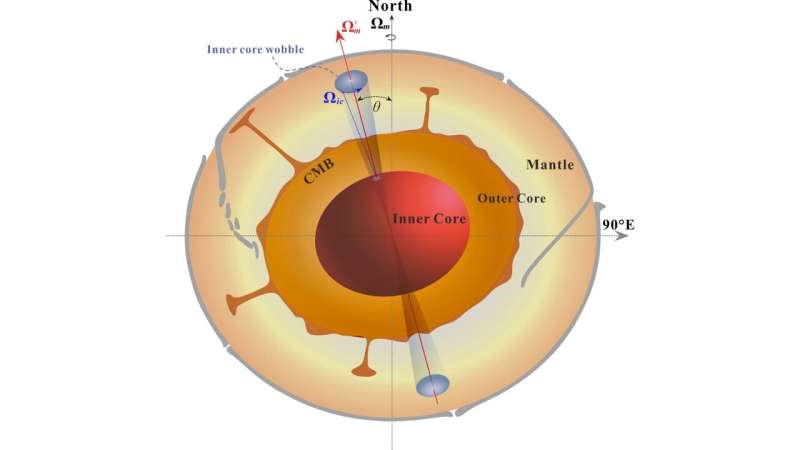Questioning Assumptions: Exploring the 8.5-Year Pattern of Earth's Inner Core

The date is December 18, 2023.
Following the guidelines and processes set by Science X, this article has been carefully edited. Our editors have confirmed its credibility by undergoing the following steps:
- It has been fact-checked
- Verified by peer-reviewed publication
- Sourced from a trusted origin
- Thoroughly proofread
Tejasri Gururaj from Phys.org is responsible for writing the article.
A group of Chinese researchers have identified evidence of an Inner Core Wobble (ICW), lasting roughly 8.5 years, within both polar motion and length-of-day variations. Their findings express a static tilt of about 0.17 degrees between Earth's inner core and mantle. This challenges traditional beliefs and sheds light on the intricacies of Earth's interior and density distribution.
The study's results are detailed in a published Nature Communications paper.
The inner core of the Earth is solid and primarily composed of iron and nickel. It lies beneath the liquid outer core and has a diameter of roughly 1,200 kilometers, or 746 miles. The inner core is essential to Earth's magnetism and its overall interior dynamics.
Studying the traits and behaviors of the inner core is essential in solving mysteries related to Earth's makeup, seismic events, and magnetic field.
ICW refers to the Earth's inner core's oscillation around its rotation axis. The term characterizes the persistent fluctuation of the inner core's axis shape.
Certainly, the new study confirms the ICW of the Earth, which exhibits a motion cycle of approximately 8.5 years. This motion is noticeable in measurements of polar motion and length-of-day changes, demonstrating variations in the Earth's spin speed.
Professor Hao Ding, the study's co-author and Dean of the Geophysics Department at Wuhan University, became captivated by the unique density formations revealed in Earth's oscillation.
Ding recounted his experience to Phys.org, mentioning how he and his Ph.D. student, Dr. Yachong An found an 8.5-year signal in Polar Motion and the changes in Length of Day, leading to this particular study.
Traditionally, the scientific grasp of Earth's rotation presupposes a uniform density distribution in the mantle and core along the radial direction. Consequently, scientists deduced the rotation axis of the Earth's core aligns with the mantle's axis.
But the Earth's free oscillation analysis suggests that density structures within the Earth are unusually diverse, casting doubt on the uniformity assumption, says Dr. Ding.
Professor Ding's 2018 analysis of the Earth's PM unveiled an approximately 8.5-year signal, indicative of an ICW. This discovery, backed by similar findings in Earth's rotation changes, challenged existing paradigms.
Leveraging these discoveries, researchers carefully studied the PM and changes in Earth's rotation to identify the 8.5-year signal in PM as a manifestation of the ICW.
The research excluded three external exciting contributors, specifically those of the atmosphere, ocean, and hydrology. Interestingly, the 8.5-year signal is not just found in PM but is consistent in the Earth's rotational axis periodic movements or length-of-day variations.
This frequent occurrence implies a significant connection between the ICW and these rotational forces.
The researchers looked at the amplitudes of the ICW in both the PM and length-of-day changes to explain the 8.5-year signal. Their analysis led to the assertion that a static tilt angle of 0.17 degrees exists between the rotation axis of the inner core and the mantle.
According to Dr. Ding, this infers a potential eastward differential rotation of less than one degree of the inner core and a misalignment in the symmetry axes of the lower mantle/core-mantle boundary layer with the upper mantle.
This indicates a potential shift in the mantle's 3D density model and poses questions regarding assumptions of the liquidity-core oblate. Specifically, it highlights possible divergences from a perfectly spherical form calculated using traditional theories.
Moreover, the roughly 8.5-year periodicity of the ICW adds another facet to the complexity of Earth. The rhythmic movement implies a density leap of approximately 0.52 g/cm3 at the inner core boundary, suggesting a noticeable shift in density at the boundary between the inner core and its outer layers.
While the research primarily focuses on the inner core, the identified static tilt and ICW may extend their influence to broader geophysical phenomena. As Dr. Ding explained, 'The static tilt may also lead to a certain change in the shape of the liquid core, resulting in a change in the fluid motion and a corresponding change in the geomagnetic field.'
The study's revelation of the Earth's ICW and its associated static tilt challenges traditional assumptions about Earth's rotation. The 8.5-year periodicity of the ICW, accompanied by a discernible density jump at the inner core boundary, unveils the intricacies of our planet's interior dynamics.
Dr. Ding and his team's future research aims to delve deeper into the stratified structure and density of the Earth's core, exploring the patterns and periods of core motions.
'The stratified structure and density of the Earth's core have always been a problem in geoscience research. We aim to delve deeper into the periodic oscillation and differential rotation of the Earth's core, seeking clarity on these conceptual theories that are different and may be difficult to coexist.'
Journal information: Nature Communications
© 2023 Science X Network




